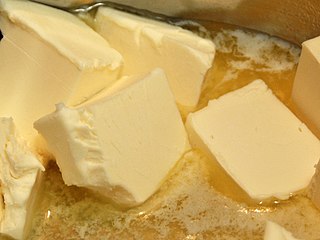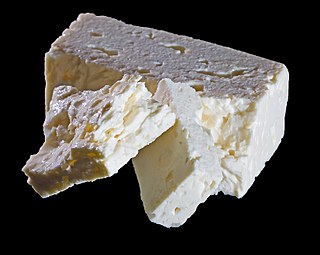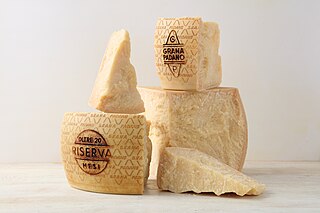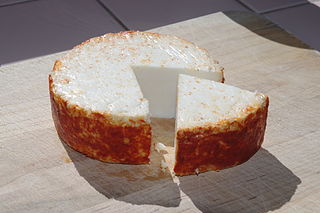
Goat cheese is produced using goat milk, the milk of domestic goats. Goat milk is commonly used to make cultured dairy products, including cheese. Myriad goat milk cheeses are produced around the world. [1] [2]

Goat cheese is produced using goat milk, the milk of domestic goats. Goat milk is commonly used to make cultured dairy products, including cheese. Myriad goat milk cheeses are produced around the world. [1] [2]









Mozzarella is a semi-soft non-aged cheese prepared by the pasta filata ('stretched-curd') method with origins from southern Italy.

Butter is a dairy product made from the fat and protein components of churned cream. It is a semi-solid emulsion at room temperature, consisting of approximately 80% butterfat. It is used at room temperature as a spread, melted as a condiment, and used as a fat in baking, sauce-making, pan frying, and other cooking procedures.

Halloumi or haloumi is a cheese that originated in Cyprus. It is made from a mixture of goat's and sheep's milk, and sometimes also cow's milk. Its texture is described as squeaky. It has a high melting point and so can easily be fried or grilled, a property that makes it a popular meat substitute. Rennet is used to curdle the milk in halloumi production, although no acid-producing bacteria are used in its preparation.

Feta is a Greek brined white cheese made from sheep's milk or from a mixture of sheep and goat's milk. It is soft, with small or no holes, a compact touch, few cuts, and no skin. Crumbly with a slightly grainy texture, it is formed into large blocks and aged in brine. Its flavor is tangy and salty, ranging from mild to sharp. Feta is used as a table cheese, in salads such as Greek salad, and in pastries, notably the phyllo-based Greek dishes spanakopita "spinach pie" and tyropita "cheese pie". It is often served with olive oil or olives, and sprinkled with aromatic herbs such as oregano. It can also be served cooked, as part of a sandwich, in omelettes, and many other dishes.

Goat cheese, goat's cheese or chèvre is cheese made from goat's milk. Goats were among the first animals to be domesticated for producing food. Goat cheese is made around the world with a variety of recipes, giving many different styles of cheeses, from fresh and soft to aged and hard.

Asiago is a cow's milk cheese, first produced in Asiago in Italy, that can assume different textures according to its aging, from smooth for the fresh Asiago to a crumbly texture for the aged cheese. The aged cheese is often grated in salads, soups, pastas, and sauces while the fresh Asiago is sliced to prepare panini or sandwiches; it can also be melted on a variety of dishes and cantaloupe. It is classified as a Swiss-type or Alpine cheese.

Ricotta is an Italian whey cheese made from sheep, cow, goat, or Italian water buffalo milk whey left over from the production of other cheeses. Like other whey cheeses, it is made by coagulating the proteins that remain after the casein has been used to make cheese, notably albumin and globulin.

Grana Padano is a cheese originating in the Po Valley, in northern Italy, similar to Parmesan. There are less strict regulations governing its production compared to Parmesan. This hard, crumbly-textured cheese is made with unpasteurized cows' milk that is semi-skimmed through a natural creaming process. To preserve the authenticity of the manufacturing processes and raw materials used to make this cheese, Grana Padano is registered as Geographical Indication in Italy since 1954 and as a European Union protected designation of origin (PDO) since 1996, and is protected in several other countries based on the Lisbon Agreement and bilateral agreements.

Telemea is the name of a Romanian cheese traditionally made of sheep's milk. Nowadays the term encompasses cheese made out of cow's milk, and in some cases of goat's, or buffalo's milk.

Añejo cheese is a firm, aged Mexican cheese traditionally made from skimmed goat's milk, but most often available made from skimmed cow's milk. After it is made, it is rolled in paprika to add additional flavor to its salty, sharp flavor, which is somewhat similar to Parmesan cheese or Romano cheese, but not as strongly flavored as cotija cheese. As a fresh cheese, it is crumbly and breaks into small pieces very easily. When dried, it acquires a firm texture, allowing it to be easily shredded or grated. Queso añejo is a good baking or grilling cheese, which is generally sprinkled on top of or stuffed into enchiladas, burritos, and tacos. Parmesan, Cotija, or feta cheese can be substituted when añejo is not available. It may also be referred to as añejo enchilado cheese or añejo.

Ġbejna is a small round cheese made in Malta from sheep milk, salt and rennet. Most sheep's milk produced in Malta is used for the production of these small cheeses.

Cheeses in Mexico have a history that begins with the Spanish conquest, as dairy products were unknown in pre-Columbian Mesoamerica. The Spanish brought dairy animals, such as cattle, sheep, and goats, as well as cheesemaking techniques. Over the colonial period, cheesemaking was modified to suit the mixed European and indigenous tastes of the inhabitants of New Spain, varying by region. This blending and variations have given rise to a number of varieties of Mexican cheeses. These are most popular in the country, although European cheeses are made, as well. Almost all cheese in Mexico is made with cows’ milk, with some made from goats’ milk. More recently, efforts have been made to promote sheep's milk cheeses. Most cheeses are made with raw (unpasteurized) milk. Cheeses are made in the home, on small farms or ranches, and by major dairy product firms. Between 20 and 40 different varieties of cheese are made in Mexico, depending on how one classifies them. Some, such as Oaxaca and panela, are made all over Mexico, but many are regional cheeses known only in certain sections on the country. Some of the least common are in danger of extinction.

Kopanisti is a salty, spicy cheese, with protected designation of origin (PDO) produced in the Greek islands of the Cyclades in the Aegean Sea such as Mykonos, Tinos, Andros, Syros, Naxos etc.; it has been produced in Mykonos for more than 300 years. It owes its special peppery and spicy taste to rapid and extensive lipolysis and proteolysis caused by abundant microbial growth encouraged by repeated kneadings performed during the ripening process.
Vermont Creamery is a creamery and artisanal cheese and butter-maker in Websterville, Vermont, USA. It was founded in 1984 by business partners Allison Hooper and Bob Reese. Previously known as the Vermont Butter and Cheese Company, the company adopted its current name in 2013.

Sheep milk cheese is a cheese prepared from sheep milk. Well-known cheeses made from sheep milk include the feta of Greece, Roquefort of France, manchego from Spain, the pecorino romano and ricotta of Italy. Yogurts, especially some forms of strained yogurt, may also be made from sheep milk.